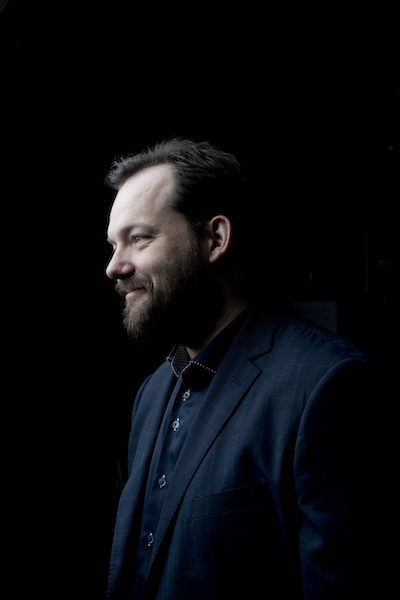Nelsons, BSO deliver blazing advocacy for Strauss’s “Symphonia domestica”

For sheer opulence, it’s hard to top Richard Strauss’s Symphonia domestica. Premiered in 1904, the forty-five-minute score illustrates a day in the life of the Strauss family – father Richard, wife Pauline, and son Franz – replete with music depicting the child thumping in the bath, a scene d’amour for the parents, and a bumptious breakfast argument (in the form of a rigorous double-fugue) for all three.
Derided from the start by those who felt that Strauss’s treatment of himself as his music’s subject smacked of self-indulgence, the Symphonia remains something of an outlier among the composer’s large orchestral works. There are musical justifications for that reception, too: at times thematically dry and a mite long-winded, it is neither Strauss’s best piece nor his finest tone poem.
But, in the right hands, the score’s unalloyed bonhomie and its spectacular orchestration make amends for any expressive shortcomings. Such was the case on Thursday night at Symphony Hall, when Andris Nelsons led the Boston Symphony Orchestra in the ensemble’s first traversal of the Symphonia since 2008.
Nelsons is one of the great Strauss conductors of the day, with a command of the composer’s musical language that is second to none. His reading on Thursday, taped for a future BSO CD release, impressed with both its sense of style and overall vision: there was purpose, shape, and momentum behind every little detail.
This interpretation reveled in the music’s fine points. John Ferrillo’s oboe solos in the opening movement were spot-on throughout, as were Mark McEwen’s accounts of Strauss’s lush oboe d’amore writing. The flute-oboe-clarinet-bass clarinet quartet that begins the third movement blended with unfailing evenness. Strauss’s harp writing, both at the climax of the Love Scene and during the finale’s boisterous coda, spoke clearly, despite everything else going on in the ensemble simultaneously.
Indeed, the Symphonia’s emphatic climaxes were grand and blazing, but never shrill. At the other end of the dynamic spectrum, the BSO delivered playing that was lush and carefully blended: the lullaby that ends the second movement was gorgeous, while the folk-like tune for woodwinds in the middle of the finale sang with sumptuous dignity.
Throughout, Nelsons proved a roundly sympathetic advocate for the Symphonia, giving the score and its many moving parts space to breathe and room to shine. Nothing felt micromanaged and even the music’s longueurs – like the second half of the third movement and the repetitious closing pages of the finale – somehow didn’t overstay their welcome. This was, in a word, a great Symphonia domestica.
One wished that the Beethoven Violin Concerto that preceded it had been so fired with purpose.
As things stood, violinist Augustin Hadelich left nothing to be desired, technically. He’s a magnificent player, with a silvery tone and flawless intonation. His performance offered fiery accounts of the outer-movement cadenzas, meltingly lyrical playing in the slow, central movement, and a brashly rustic account of the finale’s solo part.
Interpretively, though, his reading was bland: too comfortable and by-the-book. Apart from the finale, there was little sense of daring or spontaneity, nor the drawing out of phrases or rhythmic and dynamic flexibility that might glean something fresh from this well-worn piece. Beauty of tone and precision of execution aside, Hadelich’s was ultimately a safe, standard account of a canonic staple.
It was also on the slow side, which seemed to be fine with Nelsons, who led the BSO in an accompaniment that, in the first movement, was spacious to the point of being dull. Rhythms were solid and the ensemble richly blended, but little tension was to be had, either within the orchestra or between the larger group and the soloist.
The second movement was, likewise, taken broadly, though well-shaped and played with warmth. Only in the finale did the ensemble fully come to life, with raucous horns and lively mordents leading the way.
Regardless, Hadelich was received rapturously and rewarded his hearty ovation with a pristine encore of Francisco Tárrega’s delicate Recuerdas de la Alhambra.
The program will be repeated at 1:30 p.m. Friday and 8 p.m. Saturday and Tuesday at Symphony Hall. bso.org; 888-266-1200
Posted in Performances




Posted Oct 02, 2019 at 4:05 pm by James R Cassady,MD
We attended the Tuesday, Oct. 1 concert. In contrast to the above review, the Beethoven violin concerto with Hadelich was fabulous. Hadelich (and Nelsons) not only were technically flawless but phrasing, dynamics, tone and, most important overall, the scope of this incredible piece were extraordinary. It was an experience not to be missed. The reviewer’s put down of this Concerto as “well worn” shows a lack of appreciation of a truly great masterwork.